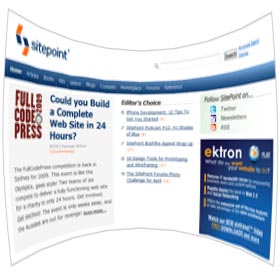 Has anyone noticed that flexible/fluid and elastic website designs are becoming rarer? Although it is not possible to determine numbers, it seems that flexible designs are not as popular or widespread as they were a few years ago.
Has anyone noticed that flexible/fluid and elastic website designs are becoming rarer? Although it is not possible to determine numbers, it seems that flexible designs are not as popular or widespread as they were a few years ago.
This is an unusual situation because flexible layouts utilize the strengths of the web as a design medium:
- Flexible sites can be made to work at many resolutions. There is no need for heated debates or research about user screen sizes. Besides, screen resolution statistics are a myth; not everyone runs their browser full-screen and many have toolbars, sidebars, or other widgets that use valuable screen estate.
- The user – not the designer – determines the dimensions of the browser window. Flexible designs give control back to the user without the need for horizontal scrolling.
- Mobile phones, such as the iPhone, and games consoles are becoming viable alternatives for web browsing. In general, these devices have smaller resolutions and can benefit from flexible web designs.
- CSS
min-widthandmax-widthallow designers to implement elastic layouts (SitePoint.com is a great example). The flexibility is restricted to ensure columns do not become too wide and unreadable or too small and hidden. There are also workarounds for IE6 if you need to fully support the browser. - A flexible layout can be switched to fixed layout with one or two CSS
widthproperties. Switching from fixed to flexible is likely to present a more significant recoding effort.
However, designing for flexibility is more difficult. Many designers produce fixed-width sites because they are easier to comprehend and mock-up in a graphics package. The trend toward highly graphical designs can also result in layouts that require pixel-perfect positioning.
Or perhaps it is the economy? Flexible designs take longer to code and test, especially given the number of browsers available today. The perceived user benefits may not be worth the longer production times and higher costs?
Or maybe I am wrong? Are there are just as many flexible website designs but I am missing them?
Are fluid designs dying out? Do your clients prefer fixed-width sites? Does flexibility offer any real advantages to your users?
Craig is a freelance UK web consultant who built his first page for IE2.0 in 1995. Since that time he's been advocating standards, accessibility, and best-practice HTML5 techniques. He's created enterprise specifications, websites and online applications for companies and organisations including the UK Parliament, the European Parliament, the Department of Energy & Climate Change, Microsoft, and more. He's written more than 1,000 articles for SitePoint and you can find him @craigbuckler.






